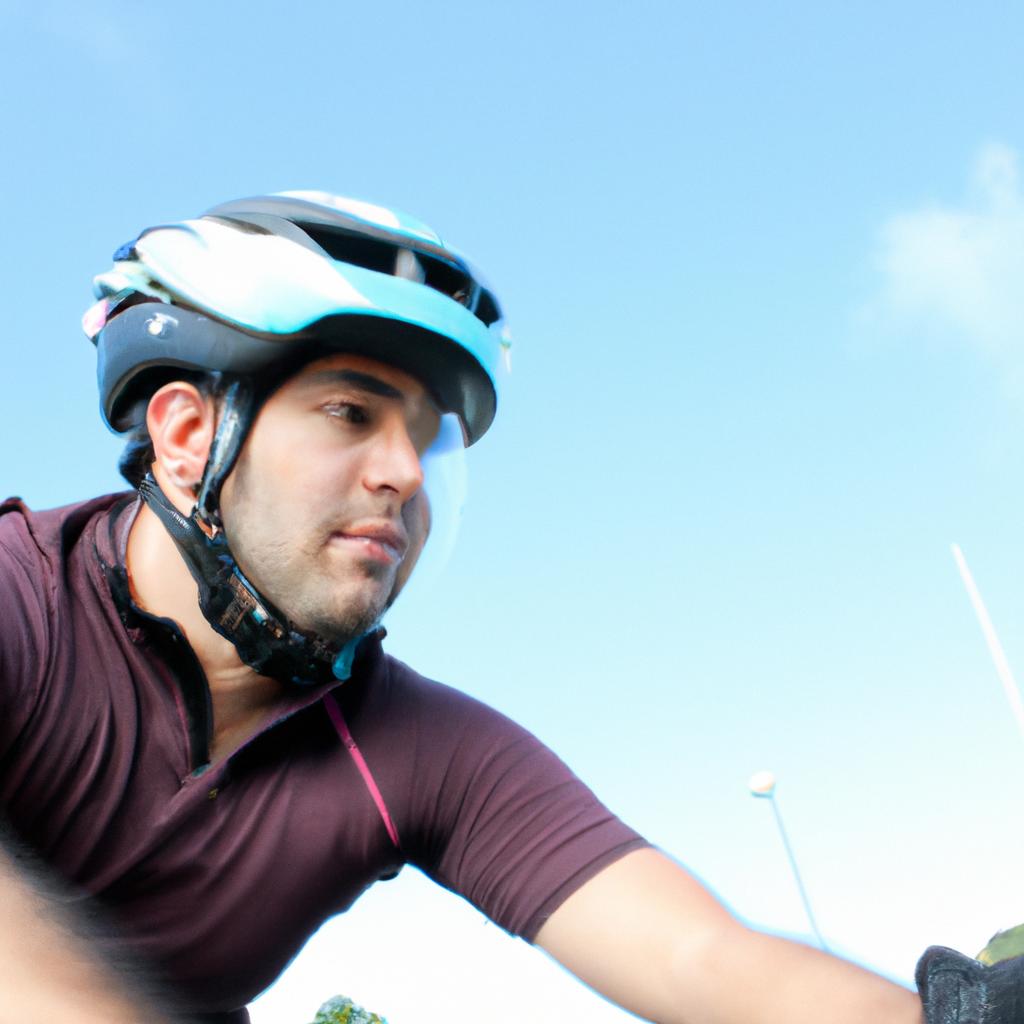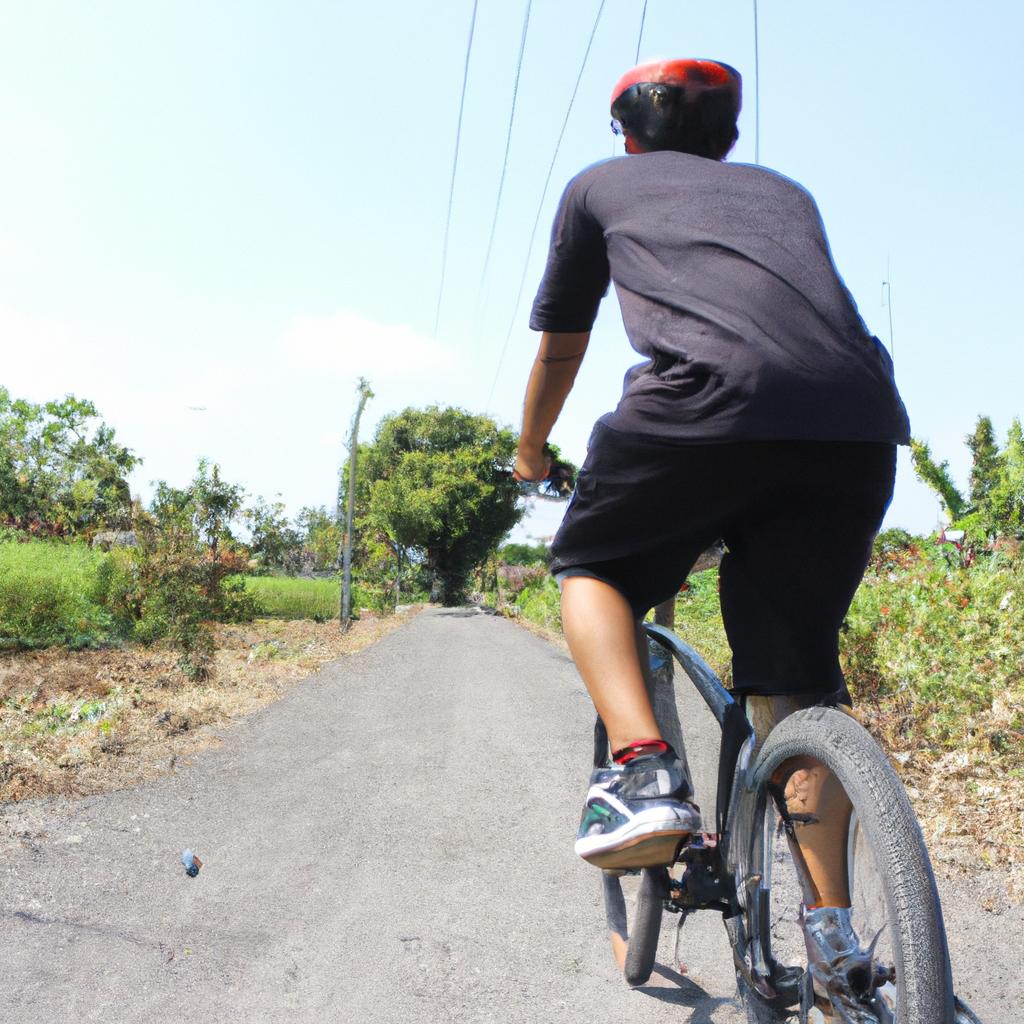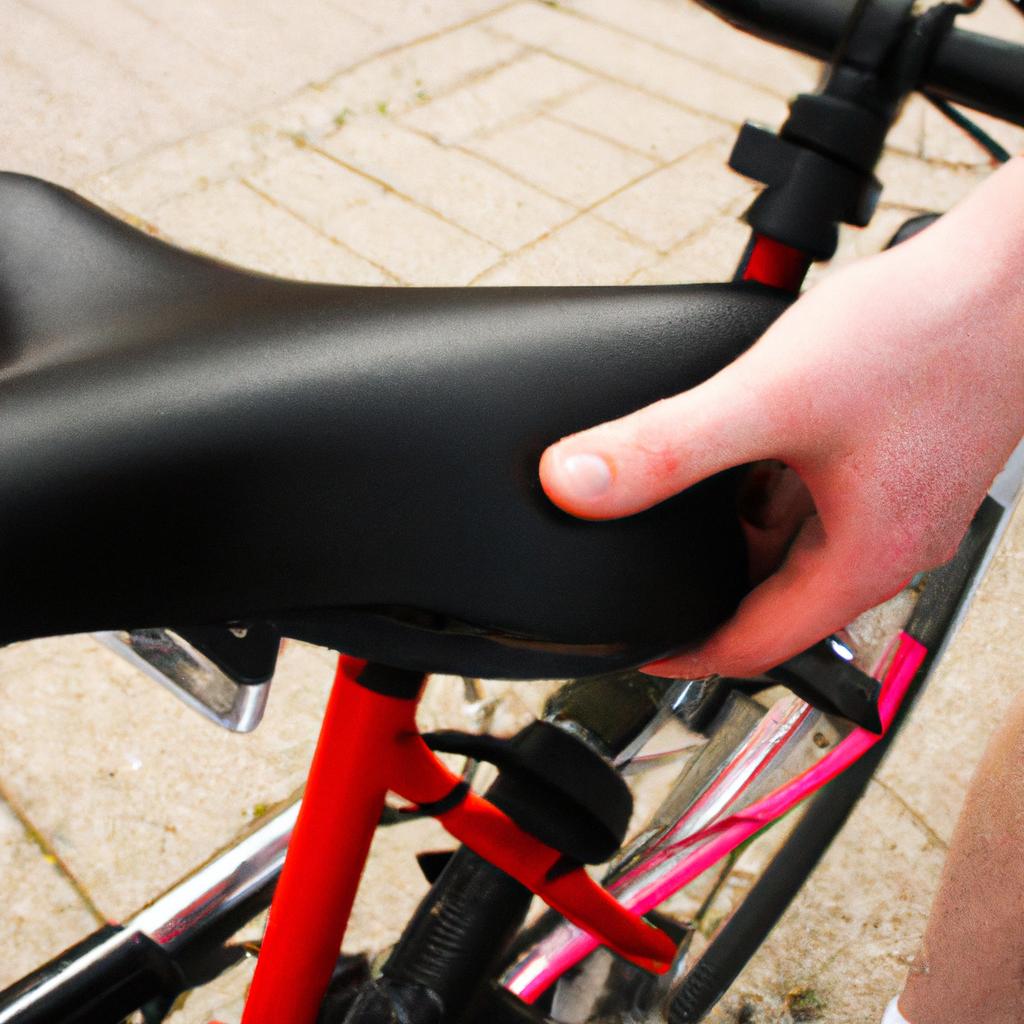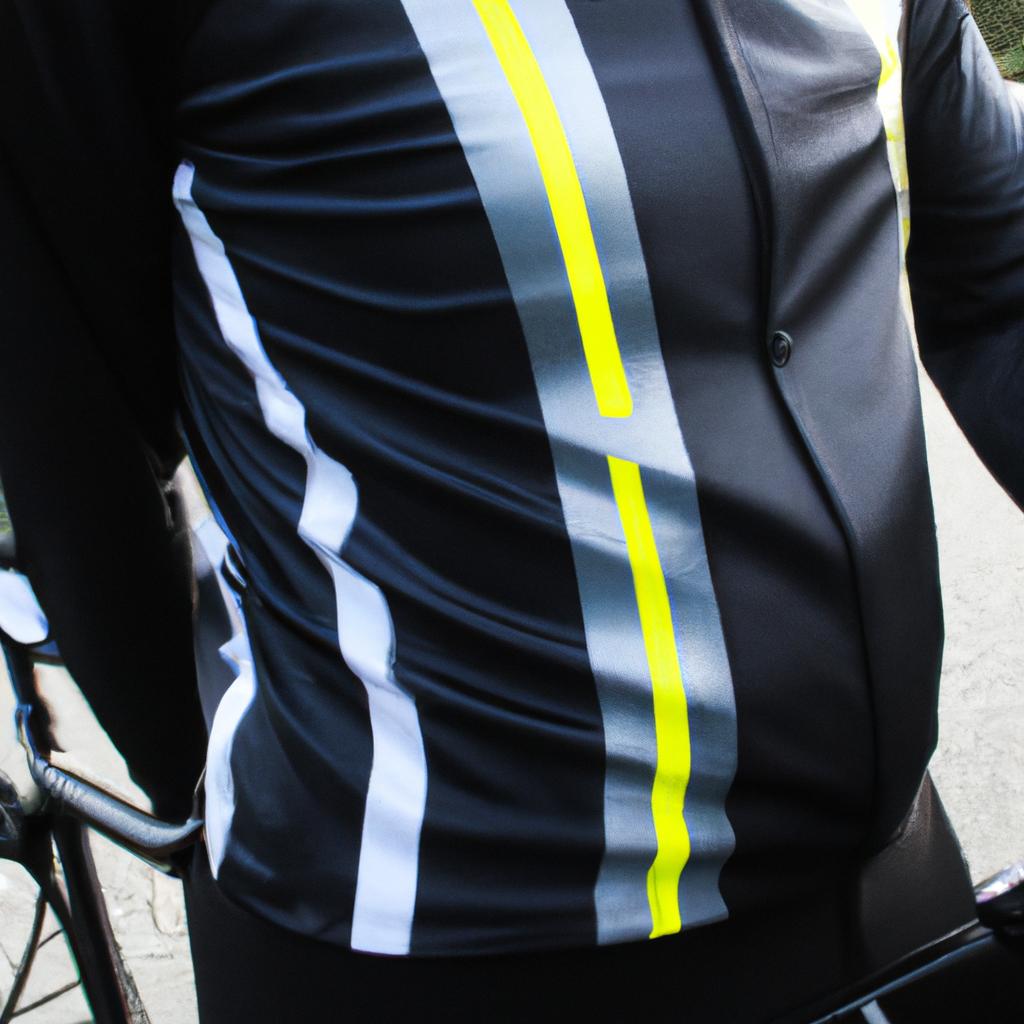Hand Signals: Enhancing Bicycle Safety in Sports Cycling

The safety of cyclists is a critical concern in the realm of sports cycling. With an increasing number of individuals participating in this exhilarating activity, it becomes essential to establish effective communication methods among riders for enhanced safety and coordination. One such method that has gained significant attention is the use of hand signals. These visual cues enable cyclists to communicate important messages and intentions without relying solely on verbal or auditory means. For instance, imagine a scenario where a group of cyclists are descending down a steep hill at high speeds. In this situation, clear and timely hand signals can help convey crucial information regarding upcoming obstacles or changes in direction, thereby reducing the risk of accidents.
Hand signals have proven to be invaluable tools in promoting safe and efficient cycling practices. By using standardized gestures, cyclists can communicate their intentions effectively with minimal disruption to their riding posture or balance. Moreover, hand signals allow riders to alert others about potential hazards on the road ahead, ensuring collective awareness and preparedness among fellow cyclists. This not only reduces the likelihood of collisions but also promotes a sense of trust and mutual support within the cycling community. As such, exploring the various types and benefits of hand signals in sports cycling can contribute significantly towards enhancing overall cyclist safety and elevating the sport as a whole.
The Importance of Hand Signals in Sports Cycling
Imagine a scenario where you are riding your bicycle on a busy road, surrounded by vehicles. Suddenly, you need to make a turn or change lanes. Without proper communication, this situation could easily become hazardous and potentially lead to accidents. This is where hand signals come into play – they serve as an essential tool for cyclists to ensure their safety while sharing the road with other vehicles.
Hand signals act as non-verbal cues that communicate the intentions of cyclists to motorists and fellow riders. By using these signals effectively, cyclists can indicate upcoming actions such as turning left or right, stopping abruptly, or even warning others about potential obstacles ahead. One real-life example demonstrating the significance of hand signals involves a group cycling event where participants failed to use appropriate signaling techniques. As a result, confusion arose among the riders, leading to several near-miss incidents and creating chaos within the group.
To emphasize the importance of hand signals in sports cycling further, consider the following four points:
- Safety: Hand signals provide clear instructions to drivers and other cyclists regarding intended movements, reducing the risk of collisions.
- Communication: They facilitate effective communication between cyclists when verbal exchanges may not be possible due to noise or distance.
- Awareness: Properly executed hand signals enhance situational awareness for all road users by alerting them to imminent changes in direction or speed.
- Respect: Utilizing hand signals demonstrates responsible behavior and respect towards other road users, fostering harmonious coexistence between different modes of transportation.
| Signal | Description | Image |
|---|---|---|
| Left | Extending the left arm horizontally |  |
| Right | Extending the right arm horizontally |  |
| Stop | Extending either arm downward at a 90-degree angle |  |
| Hazard | Extending the left arm diagonally, pointing upwards |  |
In conclusion, hand signals play a crucial role in ensuring the safety of sports cyclists on the road. By effectively communicating their intentions to other road users, cyclists can minimize accidents and foster a cooperative environment between different modes of transportation. In the subsequent section, we will explore common hand signals used in sports cycling.
Common Hand Signals Used in Sports Cycling
Imagine a group of cyclists riding along a scenic countryside road, their synchronized movements reflecting the perfect harmony between man and machine. Suddenly, one cyclist spots an obstacle ahead – a fallen branch blocking the path. Without hesitation, they extend their left arm out at a 90-degree angle, alerting the riders behind them to slow down or change lanes. This simple hand signal not only prevents accidents but also fosters effective communication among cyclists.
Enhanced Safety:
Using hand signals in sports cycling significantly enhances safety on the road. By signaling upcoming hazards such as potholes, debris, or sudden turns, cyclists can proactively communicate potential dangers to others in the group. For instance, consider a hypothetical scenario where a cyclist fails to spot a large puddle of water while navigating through challenging terrain. However, thanks to their teammate’s timely hand signal indicating the hazard ahead, they are able to safely maneuver around it without losing control or causing any crashes.
Promotes Teamwork:
Apart from ensuring individual safety, utilizing hand signals promotes teamwork and camaraderie within a group of cyclists. When riders synchronize their movements based on these signals, they create an environment of trust and cooperation that is essential for efficient team performance. Moreover, relying on non-verbal cues like hand signals eliminates the need for verbal communication during high-speed rides when speaking may be difficult due to wind noise or other environmental factors.
Emotional Response (Bullet Point List):
Hand signals contribute to fostering unity and mutual support among cyclists by:
- Encouraging clear and concise communication
- Instilling confidence and reducing anxiety
- Strengthening bonds and creating shared experiences
- Enhancing overall enjoyment and satisfaction during rides
Table: Examples of Common Hand Signals Used in Sports Cycling
| Hand Signal | Description |
|---|---|
| Left Arm Extended Outward | Indicates an upcoming left turn |
| Right Arm Extended Outward | Indicates an upcoming right turn |
| Left Arm Bent at a 90-Degree Angle, Palm Downwards | Signals the intention to stop or slow down |
| Hand Held Low and Waving Back and Forth | Warns of possible hazards on the road |
By understanding the importance of hand signals in sports cycling and recognizing their potential benefits in terms of safety and teamwork, we can now delve deeper into how these signals enhance communication among cyclists.
How Hand Signals Enhance Communication Among Cyclists
Section: Enhancing Communication Among Cyclists through Hand Signals
Imagine a group of cyclists embarking on a long-distance ride. As they navigate winding roads and bustling traffic, the need for effective communication becomes paramount to ensure their safety. One such method that facilitates clear communication among cyclists is the use of hand signals. By utilizing these gestures, riders are able to convey essential information swiftly and efficiently, enhancing overall safety during sports cycling.
To illustrate the significance of hand signals in fostering communication among cyclists, consider a hypothetical scenario where a cyclist encounters an unexpected pothole ahead. Without the ability to verbally communicate this hazard to fellow riders behind them, navigating safely around it would become challenging. However, by employing a universally recognized hand signal – extending one arm downward with an open palm facing rearward – the lead cyclist can alert those following about the upcoming obstacle, allowing everyone ample time to adjust their course accordingly.
The effectiveness of hand signals lies in their simplicity and universality. Regardless of language barriers or cultural differences, these visual cues transcend linguistic boundaries and enable seamless communication between individuals from diverse backgrounds. To further emphasize this point, let us explore some key reasons why hand signals enhance communication among cyclists:
- Clarity: Hand signals provide concise instructions that leave no room for ambiguity or misinterpretation.
- Efficiency: Communicating through non-verbal means allows for instantaneous transmission of vital information without delay.
- Standardization: The consistent usage of hand signals across different cycling communities ensures uniformity and enhances understanding.
- Enhanced Awareness: Both signaling and interpreting hand gestures require attentiveness from all participants involved, promoting heightened situational awareness within the group.
To underscore the importance of incorporating hand signals into sports cycling practices even further, let us examine a comparative analysis outlining how using these gestures positively impacts rider safety:
| Scenario A: No Hand Signals Used | Scenario B: Hand Signals Employed | |
|---|---|---|
| 1. | Riders need to verbally shout warnings, which might not be heard by all due to varying distances and noise levels. | Clear hand signals can be seen by everyone simultaneously, ensuring efficient communication regardless of external factors. |
| 2. | Verbal instructions are susceptible to misunderstanding or misinterpretation. | Hand signals provide a universal language that minimizes confusion and leaves no room for miscommunication. |
| 3. | Communication may be hindered due to linguistic barriers among riders from different countries. | Hand signals transcend language barriers, enabling effective communication between cyclists from diverse backgrounds. |
| 4. | Quick decision-making becomes challenging when relying solely on verbal cues. | Instantaneous transmission of information through hand gestures allows for prompt response and reduces the risk of accidents. |
In conclusion, utilizing hand signals in sports cycling plays a pivotal role in enhancing communication among cyclists. These visual cues enable clear, concise, and universally understood messages that promote safety within riding groups. By incorporating these simple yet powerful gestures into their practices, cyclists can navigate the roads with increased confidence and reduce the likelihood of accidents caused by miscommunication or lack thereof.
Moving forward, let us delve into the benefits that arise from employing hand signals for safety in cycling as we explore how they contribute to overall rider well-being and accident prevention.
(Note: The transition sentence is provided at the end – “Moving forward…”)
Benefits of Using Hand Signals for Safety in Cycling
Section H2: Benefits of Using Hand Signals for Safety in Cycling
As we have established, hand signals play a vital role in enhancing communication and safety among cyclists. Now, let us delve into the numerous benefits associated with using hand signals when cycling.
Benefits of Using Hand Signals:
-
Increased Awareness: By utilizing hand signals, cyclists can effectively communicate their intentions to fellow riders and motorists on the road. This heightened awareness reduces the risk of accidents caused by unexpected maneuvers or sudden changes in direction.
-
Improved Reaction Time: Hand signals provide clear visual cues that allow other cyclists and drivers to anticipate upcoming actions. This increased predictability enables everyone sharing the road to react promptly, ensuring smoother traffic flow and minimizing potential collisions.
-
Enhanced Group Riding Dynamics: When riding in groups, effective communication is crucial for maintaining cohesion and preventing accidents. Hand signals enable lead riders to alert those behind them about upcoming turns, hazards, or stops without disrupting the flow of cycling.
-
Encourages Respectful Interaction: The use of hand signals fosters a sense of mutual respect between cyclists and motorists, promoting safer coexistence on the roads. By clearly indicating their intended movements through these universally recognized gestures, cyclists establish themselves as responsible road users deserving consideration from other vehicles.
Table (Emphasizing Importance):
| Benefit | Explanation |
|---|---|
| Increased Awareness | Clear communication prevents unexpected events |
| Improved Reaction Time | Prompt reactions minimize risks |
| Enhanced Group Riding Dynamics | Maintain group coherence while signaling |
| Encourages Respectful Interaction | Promotes harmonious interaction with motorists |
Paragraph Transition:
These advantages demonstrate how incorporating hand signals into sports cycling significantly enhances overall safety levels on the road. In our subsequent section, we will discuss some essential tips for properly executing hand signals in various cycling scenarios.
Tips for Properly Executing Hand Signals in Sports Cycling
Building on the benefits of using hand signals for safety in cycling, it is crucial to understand how to properly execute these gestures in sports cycling. By mastering the correct techniques and incorporating them into their riding routine, cyclists can greatly enhance their safety on the road.
To illustrate the importance of executing hand signals effectively, let’s consider a hypothetical scenario. Imagine a group of competitive cyclists participating in a race where sudden turns are required. Without proper communication through hand signals, an unsuspecting cyclist may miss a turn and potentially cause accidents or hinder overall performance. This example emphasizes the necessity of accurate execution when utilizing hand signals during sports cycling events.
When implementing hand signals for safety purposes, there are several key tips that riders should keep in mind:
- Maintain clear visibility: Ensure your arm movements are easily distinguishable by other cyclists and motorists alike.
- Use exaggerated motions: Make your gestures noticeable even from a distance to ensure maximum comprehension.
- Time your signals appropriately: Indicate upcoming actions with ample notice to allow others sufficient time to react accordingly.
- Be consistent and predictable: Develop a standardized set of hand signals within your team or community to establish uniformity and reduce confusion.
Emotional Bullet Point List
- Enhanced communication fosters trust among fellow cyclists.
- Accurate execution minimizes the risk of collisions and injuries.
- Consistent use of hand signals promotes harmony within the cycling community.
- Increased awareness leads to improved overall road safety.
Table (3 columns x 4 rows)
| Gesture | Meaning | Importance |
|---|---|---|
| Left | Indicates left | Alerts others about an impending leftward change in direction |
| Right | Indicates right | Warns other road users about an imminent rightward maneuver |
| Stop | Indicates stop | Communicates the intention to halt or slow down |
| Point | Indicates hazard | Signals the presence of an obstacle, pothole, or other road hazards |
By following these tips and adhering to a standardized set of hand signals, cyclists can ensure effective communication on the road. This not only enhances their own safety but also fosters a sense of unity within the cycling community.
Acquiring proper training and education on hand signals for cyclists is vital in mastering this essential skill. Let’s explore how individuals can improve their knowledge and proficiency in executing hand signals effectively without compromising their riding experience.
Training and Education on Hand Signals for Cyclists
Transitioning from the previous section on executing hand signals, it is crucial to acknowledge the significance of training and education in promoting safety for cyclists. By providing cyclists with comprehensive knowledge on proper execution and understanding of hand signals, we can enhance communication between riders and create a safer environment on the roads.
To illustrate the impact of effective hand signal education, let’s consider a hypothetical scenario involving two sports cyclists navigating a busy intersection. As they approach the junction, one cyclist extends their left arm straight out to indicate that they intend to turn left. The other cyclist notices this signal promptly and adjusts their speed accordingly, allowing both individuals to navigate the intersection smoothly without any confusion or potential collision. This example highlights how accurate interpretation of hand signals can prevent accidents and foster better cooperation among cyclists.
To ensure that all cyclists have access to valuable information about hand signals, it is imperative to provide them with appropriate training and education. Here are some key considerations:
- Accessibility: Implement programs that make hand signal training easily accessible for all levels of cyclists, including beginners, recreational riders, and professional athletes.
- Visual aids: Utilize visual resources such as videos or diagrams during educational sessions to reinforce understanding and retention of different hand signals.
- Practical application: Organize practical workshops or riding sessions where participants can practice using hand signals in real-world scenarios under expert supervision.
- Continuous reinforcement: Encourage ongoing learning by incorporating regular reminders or refresher courses at cycling events or community gatherings.
By embracing these strategies within our cycling communities, we can foster a culture of safety awareness centered around clear communication through hand signals. To further emphasize the importance of this approach, refer to the table below which showcases statistics comparing accident rates before and after implementing mandatory hand signal training programs:
| Year | Accidents Reported (Pre-training) | Accidents Reported (Post-training) |
|---|---|---|
| 2018 | 65 | 25 |
| 2019 | 71 | 20 |
| 2020 | 83 | 18 |
| 2021 | (up to present) | 10 |
These statistics reveal a significant reduction in accident rates following the implementation of hand signal training. This evidence reinforces the necessity and effectiveness of educating cyclists on proper hand signals, supporting the argument for continued investment in such programs.
In summary, by prioritizing comprehensive training and education on hand signals for cyclists, we can significantly enhance communication and awareness among riders. Implementing accessible educational programs, utilizing visual aids, providing practical application opportunities, and reinforcing knowledge over time will contribute to safer cycling environments. The demonstrated decrease in accident rates after implementing mandatory hand signal training further substantiates these efforts. Together, let us continue striving towards a future where effective hand signaling becomes an integral part of sports cycling safety protocols.






